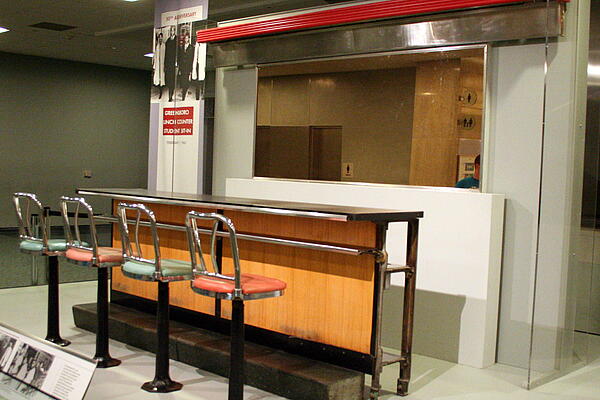Greensboro 1960
The Greensboro sit-ins proved the power of grassroots organisation and non-violent protest. They showed the determination of America’s students, who were increasingly turning to activism to fight discrimination. The sit-ins also illustrated the importance of media coverage in revealing the issue of segregation in the South.
The Greensboro sit-ins were initiated by four African American college students from North Carolina A+T College on 1 February 1960. They entered the lunch counter at Woolworth - a store that refused to serve black customers food, despite taking their custom in the shop. The students asked for food, were refused and asked to leave. They politely refused and remained seated for an hour. Although they were not arrested, they were called “stupid, ignorant… rable-rousers, troublemakers” by one black member of staff.
The students - Joseph McNeil, Izell Blair, Franklin McCain, and David Richmond - were treated like heroes on their return to their campus.
Over the next days, other students joined the demonstration. On 2 February, 24 students gathered at the Woolworth lunch counter. Again, they were not arrested but their actions caught the attention of local media.

On 4 February, white female student joined the black students and the demonstrations spread through lunch counters across Greensboro.
The sit-ins were carefully co-ordinated by the Student Executive Committee for Justice. The actions of the greensboro students soon inspired other activists and by the end of February, sit-ins had taken place at more than 30 location in seven state. By the end of April, over 50,000 students had participated.
The sit-ins symbolised a change of approach in the Civil Rights Movement. Through non-violent co-ordinated protest, African Americans were able to effectively challenge segregation. Thanks to media coverage of the campaign, students across the nation were able to take part. A future civil right leader, Robert Moses, claimed that he was inspired by the "sullen, angry and determined look" of the protesters that seemed so different to the "defensive, cringing" expression seen in most photos of protesters in the South.
Were the Sit-Ins a Success?
The public in northern, eastern and western states were horrified by the conditions in the South. Thanks to photos of students being assaulted with food at lunch counters, many people were angry. This blatant racism seemed to undermine America’s image as a democratic and free land. However, the protests only fueled the anger of Southern segregationists.
To ensure the success of their actions, students set up the Student Non-violent Co-ordinating Committee (SNCC) with Marion Barry as its first leader. This meant that there were now four civil rights movements in the South - NAACP, SCLC, CORE and SNCC. To which one were people more loyal to?
SNCC focused on issues in the South, leaving the North to take a backseat. However, Ella Baker, the executive director of the SCLC urged the SNCC to tackle housing, voting, employment and health care problems in the North. The NAACP did not endorse the sit-ins, most likely because the NAACP catered for an older generation of activists. Local NAACP groups did support the students who needed bail money or legal advic, but this was done at an individual level.
Thurgood Marshall, an associate justice of the Supreme Court, also disapproved of jail-ins, whereby protesters ensured they were arrested to clutter up the jails.
In terms of achieving desegregation, the sit-ins did have some effect. Stores in Atlanta, the city most associated with King, desegregated. The Woolworth at Greensboro eventually agreed to desegregate its food counter in July 1960, having lost $200,000 dollars of business or 20 per cent of its anticipated sales.
However, the value of the sit-ins was far greater than the desegregation of a few lunch counters. Through media coverage they had successfully highlighted the horrors of segregation in the South.
Moverove, news coverage encourage thousands of students to take part. Over 70,000 people participated. Sit-ins were used to protest about segregated lunch counters, swimming pools, transport facilities, libraries art galleries, beaches and parks. The Greensboro sit-ins gave birth to a form of non-violent protest that would come to define the Civil Rights Movement.
Most importantly, the sit-ins gave African Americans an idea of their own power in the fight for civil rights. One participant described this realisation:
"I myself desegregated a lunch counter, not somebody else, not some big man, some powerful man, but little me. I walked the picket line, and I sat in, and the walls of segregation toppled."
See also: The 1960 Civil Rights Act
MLA Citation/Reference
"Greensboro 1960". HistoryLearning.com. 2026. Web.
